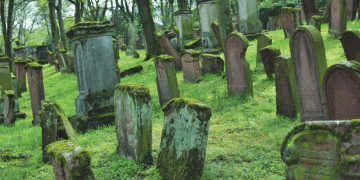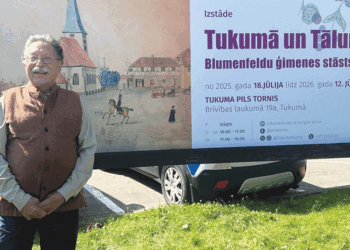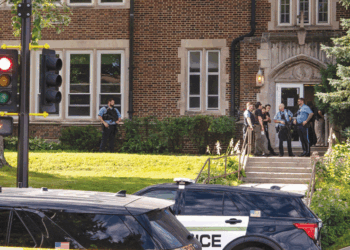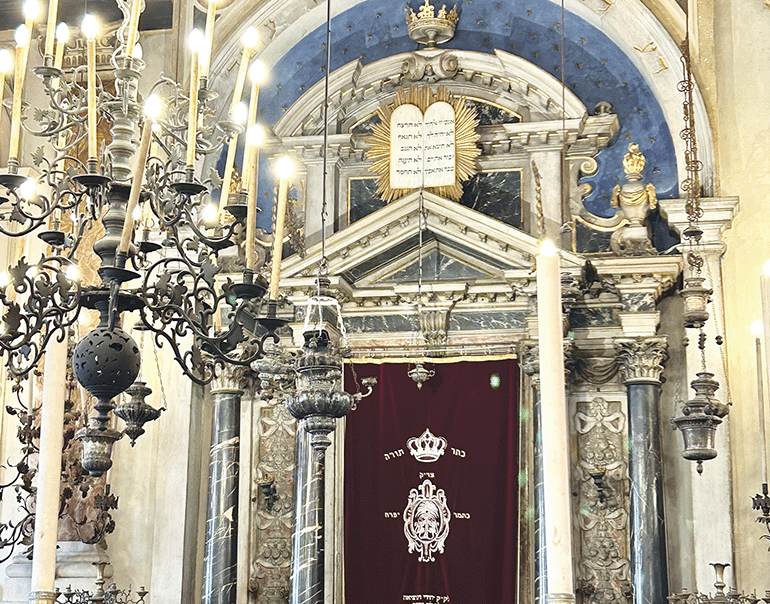
On March 5, my wife, Maj-Britt Syse, and I left MSP on a flight to Schiphol Airport in Amsterdam. We had a brief layover and continued to Venice, Italy. We were planning to reunite with our expat son, Max, who has been living in Copenhagen, Denmark, for the past six years.
When you arrive by air at Marco Polo Airport in Venice, there are varied options for getting into the fabled city. There are taxis, buses and water conveyances. We chose the Alilaguna public water bus, which costs 15 euros. (A private water taxi runs about 140 euros.)
We traveled to Europe without a checked bag for the first time ever, so after leaving the plane we followed the signs in the airport to the dock. The manager of our hotel in Venice had advised us to take the Orange Line water bus, which navigates through the Grand Canal and terminates at the Giglio dock, around the corner from our little hotel on Piazza Pianca, on San Marco island. We were a short walk from the famous Piazza San Marco, the site of the basilica and the Doge’s Palace.
I wrote about my previous trip to Italy (“Vacanza in Italia”) in the Aug. 11, 2017, issue of the Jewish World. I didn’t go to Venice on that visit; my previous experience of Venice was in 1978, nearly 50 years ago, when I was traveling in Europe with my girlfriend at the time. Venice is a fabulous city, but it now caters to some 20 million tourists a year. With some effort you can still find areas off the beaten tourist track, and restaurants that serve authentic Venetian fare.
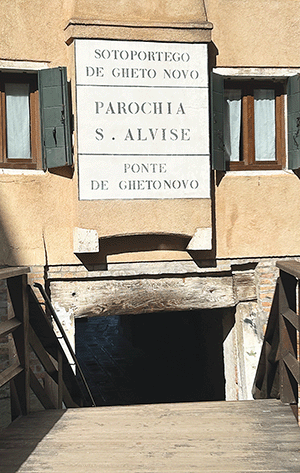
I had numerous sites marked on my Google Maps app, so after a cappuccino and a croissant, we boarded the vaporetto, public water bus, for a short cruise to the island of Cannaregio, and the Jewish Ghetto.
Jews were allowed to settle in the walled-off ghetto in 1516. The Geto Nuovo — and any ghetto around the world — gets its name from the public foundries where Venetians cast (gettavano) the cannon, according to Giuseppe Tassini, in his Curiosità Veneziane; thus, the area was called el getto because it contained numerous furnaces for bronze-casting, as per the website of the Jewish Community of Venice.
We bought tickets to tour the German and Spanish synagogues, wandered through the streets of the Jewish Ghetto (with bakeries selling hamantashen) and then took the vaporetto to the island of San Polo.
For old time’s sake, I wanted to visit the Basilica di Santa Maria Gloriosa dei Frari, known as the Frari church, which I saw in 1978. Perhaps the most important Gothic church in Venice, the cavernous Frari contains a huge altarpiece, “Assumption of the Virgin,” by Titian, painted from 1515 to 1518. The dramatic painting created controversy when it was originally unveiled.
I’ve been fascinated by the famous churches of Europe and masterpieces of Christian art since first venturing to the Old Land of Woe, in 1971. Venice is a storehouse of amazing churches and artworks. Just steps from our hotel stands the church of Santa Maria Zobenigo, also known as the Chiesa di Santa Maria del Giglio. The church dates from the 10th century, and its Baroque Venetian façade, said to be one of the finest in Venice, was created in the late 17th century. In a side chapel of the church, one finds a painting by the Flemish master Peter Paul Rubens, “Madonna and Child with Young St. John,” the only painting by Rubens in Venice.
We were only two nights in Venice, so we were able to sample some attractions. We took the water bus back to the airport and met our son Max at the Budget rental car desk. Then we started driving around northeast Italy.
Our first stop was Verona, a beautiful city that inspired plays by Shakespeare, including Romeo and Juliet. An enterprising tour guide created “Juliet’s balcony” some years ago. And tourist couples can go up on the balcony for a photo — I think that there’s an admission price.
In Verona, we reunited with Silvia, Max’s Italian girlfriend. She was helping her father, Angelo, who had a booth at Model Expo Italy 2025, a sprawling exposition of toys, robots and whatnot at the convention center. Angelo has a sideline of selling model railroad cars and accessories (HO and N scale, for the model railroaders reading this). His business is called Treno Gheno. We settled into our Airbnb rental, then Max took us to a nearby bar for aperitivos.
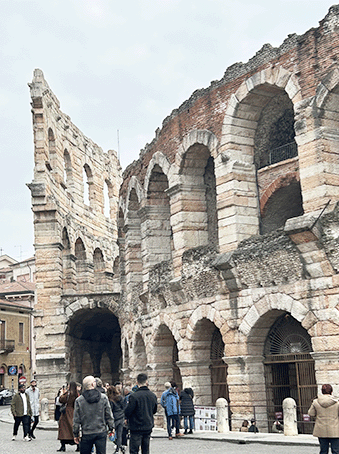
In Verona, we took the funicular railway up to the San Pietro Castle and a spectacular view of the city. We descended and walked around, grabbed another coffee (espresso or macchiato) and made our way to the Verona Arena, one of the best-preserved ancient structures of its kind, dating to 30 C.E. In ancient times, 30,000 people could pack the arena, which is still in use as a concert venue.
Our traveling party, along with Angelo, Silvia’s sister and brother-in-law, and friends, gathered for a late dinner. We enjoyed many fine meals on our travels in Italy. My wife has photos of many of them.
From Verona we drove to Padua, a town famous for the Basilica of St. Anthony of Padua, which was completed in the early 14th century and contains the tomb of the saint. An ornate reliquary contains the saint’s tongue, jawbone and vocal cords. Our rental apartment was a short walk from the basilica. We also visited the Scrovegni Chapel, which contains frescoes by Giotto that were completed in 1305.
Also, Maj-Britt, Max and I visited the Jewish Museum of Padua, which includes a guided tour of the nearby Italian Synagogue. A military jeep and soldiers were stationed by the shul.
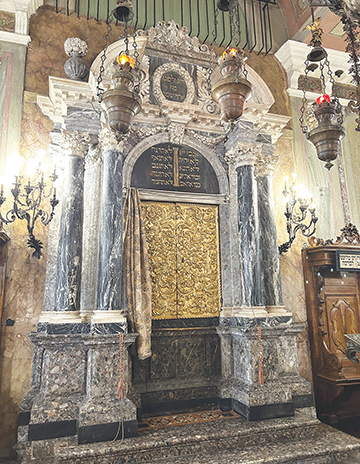
Like Venice, Padua had a compact Jewish ghetto, and the Jews, who arrived there in the late 13th century, have an illustrious history in the city. As far back as the early 16th century, Jews were admitted as medical students in the local university, the second oldest in Italy. The Jewish Museum of Padua is a one-room affair, with exhibits displaying communal history, Jewish holidays and ritual objects.
I do not put myself forward as an authority on the Jews of Italy. There is a lengthy entry on “Italy” in the Encyclopaedia Judaica, which begins: “Jews have lived in Italy without interruption from the days of the Maccabees until the present, through a period of 21 centuries. Although they were never subjected to general expulsion, there were frequently partial ones. They often enjoyed good relationships with the rulers and general population or were granted special privileges. They remained few in number, refrained from attracting attention, were intellectually alert, and continued faithful to their tradition. The record of Italian Jewry thus provides one of the most complex and fascinating chapters in the history of the Jewish Diaspora.”
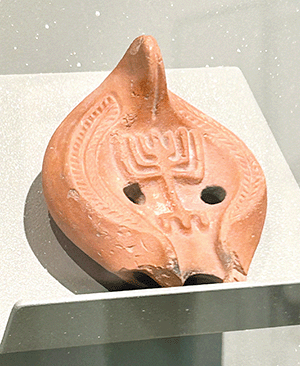
Rambling around Italy you never know when a reminder of our Jewish past will crop up. One of our more fascinating stops was in the town of Aquileia, which was an important city during the time of the Roman Empire. The excellent National Archeological Museum of Aquileia is bursting with Roman era statuary, jewelry and architectural odds and ends. In one display, I found a ceramic oil lamp decorated with a menora, the ancient symbol of Judaism. Jewish artisans, glass blowers, ceramicists, etc. plied their trades in Aquileia nearly 2,000 years ago.
On the road in Italy, we visited wineries, churches and shuls. In the region of Friuli-Venezia Giulia, we visited fortified medieval cities: Cittadella, Palmanova, Udine and Cividale del Friuli. We would walk into the town center, have coffee or lunch and look around.
And then we had another reunion, in Trieste, a lesser known city on the eastern edge of Italy. We visited with Davide, who was our foreign exchange student in 2012. During the school year, he lived with us and attended South High School in Minneapolis. He played varsity basketball. Now, Davide and his partner Martina have a toddler, Niccolò, who is slightly younger than my granddaughter. We last visited Trieste in 2017, when Davide’s parents, Elisbetta and Mario, arranged visits to the Great Synagogue, the Risiera di San Sabba concentration camp (which was run by the Gestapo), Miramare Castle, Duino Castle, etc. So, in March we enjoyed a more relaxed time with our Italian friends.
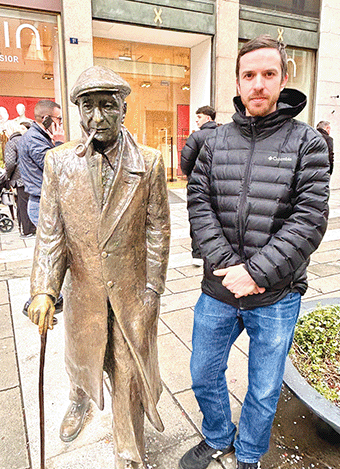
Shortly after our arrival in Trieste, Max and I walked over to the Grand Canal and saw the statue of James Joyce, the famous Irish writer who wrote his masterwork Ulysses while living in the city. And we visited Libreria Antiquaria Umberto Saba, the antiquarian bookstore established by Umberto Saba, a Jewish poet and novelist. His statue stands near the bookstore.
It was a wondrous time for us in Italy. We don’t see Max too often, since he lives on the other side of the pond, so spending a week traveling through Italy with him was the highlight of our vacation. Before returning the rental car in Venice, we drove up into the Julian Alps, to Tolmin, Slovenia, where we stayed one night. This was the nature part of our trip. It’s a beautiful area that attracts hikers and mountaineers.
***
My wife and I flew out of Venice on March 16. It was an eventful return, as our flight from JFK to MSP was delayed far into the night and then canceled. We were forced to book a hotel room by JFK for the night and catch a return flight the following evening. That flight was delayed by two hours.
The jet lag has worn off, and we’re coming to grips with the perilous and ridiculous state of politics in the U.S.
When I returned from Italy in 2017, I wrote about my experiences, including insights about the history of fascism in Europe. As I mentioned, we visited the Risiera, the only concentration camp in Italy with a crematorium, so repression was on my mind as I returned to life here under the first Trump administration.
“We should not delude ourselves into thinking that it can’t happen here,” I wrote eight years ago. “Under the rubric of terrorism or in the face of a serious economic decline, authoritarian figures could lead the U.S. into a regime of foreign wars and domestic repression. We have a president who habitually lies and displays a complete disregard for democratic norms. He attacks the press, the judiciary, his own partisans, and denigrates religious and ethnic minorities, and women, in the crudest terms. Italy once had a leader like this. His name was Benito Mussolini and he declared that he would make Italy great again.”
The Jewish World will continue to report and comment on the drift toward fascism in the U.S., under the aegis of the Trump administration. Perhaps, we can find ways to remediate the damage that already has been done over the past few months, and act together in the spirit of tikkun olam, the repair of the frayed fabric of our society.
The editors and staff of the American Jewish World wish all of our readers a happy and meaningful Passover.
Mordecai Specktor / editor [at] ajwnews [dot] com
(American Jewish World, April 2025)








